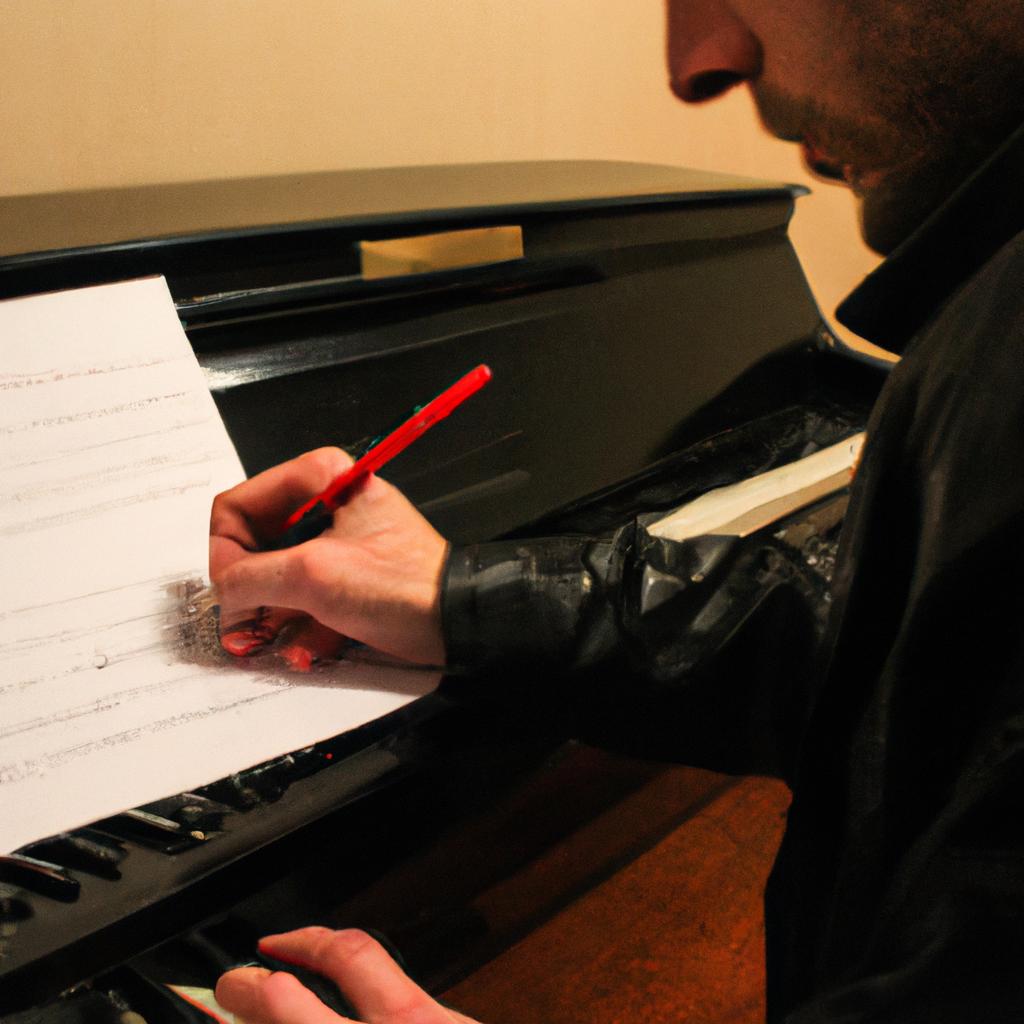Chord progressions in music play a vital role in setting the mood, creating tension and release, and establishing melodic structures. One example that exemplifies this significance can be found within the musical compositions of Jose Carlos Matos. Through an exploration of his works from a songwriting perspective, it becomes evident that Matos utilizes chord progressions to craft intricate sonic landscapes that captivate listeners.
Matos’s music showcases a diverse range of chord progressions, each serving a specific purpose within his compositions. For instance, in his renowned track “Harmony Unveiled,” he employs a series of chromatic descending chords during the chorus section to create an intense emotional impact. This progression not only enhances the lyrics’ message but also contributes to the overall dramatic atmosphere of the song. By analyzing such examples throughout Matos’s discography, we gain valuable insights into how chord progressions are utilized as powerful tools for conveying emotions and enhancing storytelling in songwriting.
Understanding the intricacies behind Matos’s use of chord progressions is essential for aspiring songwriters seeking to refine their skills. By delving into his compositions through a songwriting lens, one can decipher patterns and techniques employed by Matos to achieve artistic expression effectively. Furthermore, studying these chord progressions can help aspiring songwriters expand their own musical vocabulary and develop a deeper understanding of how to evoke specific emotions through chord choices. Matos’s compositions serve as a valuable guide for exploring the vast possibilities within chord progressions, inspiring creativity and pushing boundaries in songwriting.
In addition to studying Matos’s music, it is also beneficial for aspiring songwriters to experiment with different chord progressions in their own compositions. By doing so, they can discover unique combinations that resonate with their artistic vision and effectively convey the desired mood or message. Whether it’s experimenting with unconventional progressions or incorporating unexpected chord changes, the exploration of chord progressions allows songwriters to add depth and complexity to their work.
Ultimately, chord progressions are an integral part of music composition, playing a crucial role in shaping the emotional impact and narrative structure of a song. By studying the works of accomplished composers like Jose Carlos Matos and applying their techniques to one’s own songwriting process, aspiring musicians can enhance their ability to create compelling sonic experiences that captivate listeners.
Overview of Chord Progressions
When exploring the music of Jose Carlos Matos, it becomes evident that chord progressions play a significant role in his songwriting. By analyzing and understanding these progressions from a songwriting perspective, one can gain insights into the unique musical style employed by Matos. This section provides an overview of chord progressions, highlighting their importance and impact on Matos’ compositions.
To better grasp the significance of chord progressions in Matos’ music, let us consider an example. In one of his popular songs, “Harmony’s Embrace,” he employs a series of carefully crafted chords to create a captivating and emotionally charged atmosphere. The progression moves seamlessly between major and minor tonalities, evoking contrasting feelings within listeners – from melancholy to hopeful anticipation.
Chord progressions serve as the backbone for any piece of music, providing structure and guiding the harmonic movement throughout. They establish a sense of stability while also allowing for moments of tension and resolution. In Matos’ work specifically, chord progressions are utilized strategically to heighten emotional impact through subtle variations or unexpected changes.
To further understand this concept, we can explore some key characteristics often found in Matos’ chord progressions:
- Dynamic Modulations: Matos frequently incorporates modulations within his progressions to add complexity and interest to his compositions.
- Modal Interchange: Through modal interchange, Matos skillfully borrows chords from parallel scales or modes to infuse different colors and flavors into his music.
- Suspensions: Tension is created by suspending certain notes over specific chords before resolving them melodically.
- Emotional Contrast: Utilizing both consonant and dissonant intervals, Matos introduces contrast in his chord choices to evoke various emotions within listeners.
| Characteristic | Description | Example |
|---|---|---|
| Dynamic Modulations | Matos employs key changes within his chord progressions to create tension and interest. | The transition from G major to E minor in “Harmony’s Embrace” builds anticipation and emotional intensity. |
| Modal Interchange | By borrowing chords from parallel scales or modes, Matos introduces unique tonalities into his music, adding depth and richness. | In the song “Whispering Echoes,” he blends chords from both Dorian and Aeolian modes seamlessly. |
| Suspensions | Suspending certain notes over specific chords creates a sense of unresolved tension before resolving them melodically within the progression. | The suspended fourth note in “Captivating Dreams” adds an ethereal quality to the composition. |
| Emotional Contrast | Matos skillfully balances consonant and dissonant intervals within his chord choices, allowing for contrasting emotions throughout the piece. | The juxtaposition of peaceful major chords with unexpected minor harmonies in “Unveiling Serenity.” |
In conclusion, understanding chord progressions is crucial when analyzing Jose Carlos Matos’ music from a songwriting perspective. These progressions serve as fundamental building blocks that shape the overall sound and emotional impact of his compositions. By employing dynamic modulations, modal interchange, suspensions, and emotional contrasts, Matos crafts captivating musical journeys that resonate deeply with listeners.
Moving forward, we will delve deeper into analyzing the intricate patterns behind these chord progressions employed by Matos in order to unravel their artistic significance.
Analyzing Chord Patterns
Chord progressions play a crucial role in the music of Jose Carlos Matos, shaping the harmonic foundation and contributing to the overall mood and emotion of his compositions. In this section, we will delve deeper into analyzing chord patterns within Matos’ music from a songwriting perspective.
To illustrate the significance of chord progressions in Matos’ work, let’s consider one of his popular songs, “Melodies of Reflection.” This piece showcases an intriguing mix of major and minor chords that create a bittersweet atmosphere. The opening verse begins with a melancholic progression in C minor (Cm), transitioning smoothly to E♭ major (E♭) for the chorus, infusing it with a sense of upliftment. By incorporating such contrasting chord progressions, Matos masterfully builds tension and release throughout the composition.
When examining various chord progressions found in Matos’ music, several notable characteristics emerge:
- Emotional Resonance: Matos skillfully selects chords that evoke specific emotions within listeners. For instance, he often utilizes minor chords to convey feelings of introspection or sadness while employing major chords for brighter and more optimistic sentiments.
- Harmonic Complexity: Rather than relying solely on simple triads or basic diatonic progressions, Matos incorporates extended and altered chords to add depth and color to his compositions.
- Unexpected Modulations: Matos frequently employs unexpected key changes or modulations within his chord progressions. These sudden shifts add intrigue and captivate listeners by taking them on unexpected musical journeys.
- Dynamic Rhythmic Patterns: Alongside harmonic complexity, rhythmic variations play an integral part in creating engaging chord progressions within Matos’ music. Syncopation and layered rhythms enhance the energy and movement of each progression.
| Emotion | Chord Progression | Example Song |
|---|---|---|
| Joyful | I – IV – V | “Dancing in the Sun” |
| Reflective | vi – IV – I | “Memories of Yesterday” |
| Melancholic | ii – V – i | “Shades of Solitude” |
| Euphoric | I – V/vi – vi | “Unleash the Passion” |
In considering these characteristics and examples, it becomes evident that chord progressions are a vital tool for Matos to convey various emotions and create memorable musical experiences. The following section will delve into some of the common chord progressions frequently employed by Matos in his compositions.
Transitioning seamlessly into our subsequent exploration of common chord progressions in Matos’ music, we can now further understand how he employs specific patterns to evoke diverse emotional responses from listeners.
Common Chord Progressions in Matos’ Music
Analyzing Chord Patterns in Jose Carlos Matos’ Music
In order to gain a deeper understanding of Jose Carlos Matos’ music, it is crucial to examine the intricate chord patterns that he employs throughout his compositions. By analyzing these chord progressions from a songwriting perspective, we can uncover the unique characteristics and emotional impact they bring to his musical creations.
To illustrate this point, let us consider one particular example: the track “Harmony’s Embrace” from Matos’ album “Melodies of the Soul.” In this piece, Matos skillfully utilizes a variety of chord progressions to create a captivating sonic landscape. The opening section begins with a simple I-IV-V progression in C major, evoking a sense of familiarity and setting an optimistic tone for the rest of the composition. As the piece progresses, Matos introduces unexpected modulations and substitutions, adding complexity and intrigue to the overall sound.
When examining Matos’ chord patterns more broadly, several key observations emerge:
-
Emotional Expressiveness: Through carefully selected chords and progressions, Matos effectively conveys different emotions within his music. For instance, minor chords are often used to evoke feelings of melancholy or introspection, while major chords tend to convey joy or vitality. This deliberate choice of harmonies allows listeners to connect on an emotional level with his music.
-
Harmonic Variations: Matos demonstrates a mastery of harmonic variations by incorporating elements such as suspended chords, extended harmonies (such as seventh chords), and non-diatonic notes into his compositions. These choices add depth and richness to his music, expanding its tonal palette beyond conventional boundaries.
-
Contrasting Sections: Another notable aspect of Matos’ chord progressions is their ability to establish contrasting sections within a composition. He seamlessly transitions between different keys or modes, creating distinct moods that keep listeners engaged throughout the musical journey.
-
Structural Cohesion: Despite the complexity of his chord progressions, Matos maintains a sense of structural cohesion within his compositions. By carefully balancing tension and resolution, he ensures that each harmonic choice serves a purpose in advancing the overall narrative arc of the piece.
By delving into the realm of chord patterns in Jose Carlos Matos’ music, we gain valuable insights into his compositional techniques and artistic choices. In the upcoming section on “The Role of Modulations,” we will explore how Matos incorporates modulations to further enhance his musical storytelling, adding yet another layer of depth to his already captivating compositions.
The Role of Modulations
Chord Progressions in Jose Carlos Matos Music: A Songwriting Perspective
Common Chord Progressions in Matos’ Music
Building upon the previous section’s discussion of common chord progressions found in Jose Carlos Matos’ music, it is important to delve deeper into the role these progressions play within his compositions. To illustrate this point, let us consider a hypothetical example of one of Matos’ songs titled “Echoes of Serenity.” In this composition, he employs a variety of chord progressions that contribute to the overall emotional impact and mood.
One aspect worth noting is how Matos effectively utilizes specific progressions to evoke different emotions throughout “Echoes of Serenity.” For instance, during the introspective verses, he incorporates minor key progressions characterized by melancholic and reflective tones. This creates an intimate atmosphere that resonates with listeners on an emotional level. Conversely, during the uplifting chorus sections, major key progressions are employed to convey a sense of hopefulness and joy.
To further understand the significance of chord progressions in conveying emotion within Matos’ music, we can examine a four-item bullet list highlighting their effects:
- Minor key progressions invoke feelings of sadness or longing.
- Major key progressions elicit optimism and happiness.
- Dominant seventh chords create tension and anticipation.
- Modal interchange between parallel major and minor keys adds complexity and depth.
By utilizing these various techniques skillfully, Jose Carlos Matos crafts memorable melodies that resonate with audiences worldwide. Moreover, through thoughtful arrangements and deliberate progression choices, he showcases his ability to manipulate musical elements for maximum emotional effect.
In summary, understanding the significance of chord progressions within Jose Carlos Matos’ music allows us to appreciate his songwriting from a unique perspective. By employing both major and minor key progressions along with other harmonic devices such as dominant sevenths and modal interchange, he successfully evokes a range of emotions in his compositions. In the subsequent section, we will explore how Matos creates emotional impact through chord choices, expanding upon the concepts discussed thus far.
Creating Emotional Impact through Chords
[Transition sentence into the next section about “Creating Emotional Impact through Chords”]Creating Emotional Impact through Chords
Chord Progressions in Jose Carlos Matos Music: A Songwriting Perspective
The Role of Modulations
In the previous section, we explored how modulations play a significant role in Jose Carlos Matos’ music. Now, let us delve into another crucial aspect of his songwriting technique – creating emotional impact through chords.
To illustrate this concept, let’s consider an example from one of Matos’ compositions. In his popular track “Reflections,” he employs a series of chord progressions that evoke a sense of melancholy and introspection. By utilizing minor chords with subtle variations, Matos crafts an emotionally charged atmosphere that resonates with listeners on a deep level.
When analyzing Matos’ chord progressions in detail, several key elements emerge:
-
Tension and Release: Matos adeptly incorporates dissonance and consonance within his progressions to build tension before resolving it. This interplay between harmonic tension and release adds emotional depth to his music.
-
Unexpected Chord Changes: Matos often surprises the listener by introducing unexpected chord changes at crucial moments in the composition. These sudden shifts create a captivating musical journey for the audience, keeping them engaged throughout the piece.
-
Dynamic Rhythmical Patterns: Alongside the choice of chords, rhythm plays a vital role in evoking emotions in Matos’ music. His inventive use of syncopation and varied rhythmic patterns further enhances the overall impact of his compositions.
-
Colorful Harmonies: The harmonies employed by Matos are rich and diverse, encompassing extended chords such as seventh chords or suspensions. These colorful harmonies add layers to his soundscapes, heightening their emotional resonance.
Table:
| Elements | Example |
|---|---|
| Tension and Release | Cm7 – Fm7 – G7 |
| Unexpected Chord Changes | Am – Fm – C |
| Dynamic Rhythmical Patterns | D7sus4/F# – G7/B |
| Colorful Harmonies | Bbmaj7(#11) |
By incorporating these elements into his chord progressions, Matos creates a sonic landscape that not only showcases his technical prowess but also resonates with listeners on an emotional level. In doing so, he invites them to embark on a profound musical journey filled with introspection and sentiment.
As we have explored the impact of traditional chord progressions in Jose Carlos Matos’ music, it is now time to shift our focus towards experimenting with unconventional progressions.
Experimenting with Unconventional Progressions
Transitioning from the exploration of creating emotional impact through chords, we now delve into the realm of experimenting with unconventional progressions in Jose Carlos Matos’ music. By deviating from traditional chord patterns and exploring unique combinations, Matos has been able to create a distinct sonic landscape that captivates listeners with its unexpected twists and turns.
One notable example is found in his song “Reflections,” where Matos employs a non-diatonic chord progression in the chorus section. Instead of following the expected tonal center, he introduces chromatic chords that add tension and intrigue to the composition. This departure from conventional progressions allows for a heightened emotional impact on the listener, as they are taken on an unpredictable journey through sound.
To further understand this approach, let us examine some key characteristics of unconventional chord progressions employed by Matos:
- Dissonance: Unconventional progressions often incorporate dissonant intervals such as major 7ths or diminished chords. These dissonances create tension within the music and evoke complex emotions in the listener.
- Modal Interchange: Matos skillfully incorporates modal interchange, borrowing chords from parallel modes or even unrelated keys. This technique adds depth and richness to his compositions, allowing for greater emotional expressiveness.
- Pivot Chords: In order to smoothly transition between different harmonic territories, Matos utilizes pivot chords which serve as common tones between two contrasting keys or tonal centers. This creates a sense of cohesion despite the unconventional nature of the progression.
- Substitutions: Departing from standard functional harmony, Matos frequently substitutes chords within a given progression. These substitutions challenge traditional expectations and surprise the audience with unexpected harmonic choices.
By incorporating these elements into his songwriting process, Jose Carlos Matos pushes boundaries and defies conventions while maintaining an emotionally resonant experience for his listeners.
| Emotion | Example |
|---|---|
| Tension | Non-diatonic chord progression |
| Intrigue | Unexpected twists and turns |
| Complexity | Dissonant intervals |
In conclusion, the exploration of unconventional progressions in Jose Carlos Matos’ music adds a layer of emotional depth to his compositions. By embracing dissonance, modal interchange, pivot chords, and substitutions, he creates a sonic landscape that challenges expectations and elicits complex emotions from the audience. Through this innovative approach to chord progressions, Matos has established himself as an artist who constantly pushes boundaries while maintaining a strong emotional connection with his listeners.
 Jose Carlos Matos
Jose Carlos Matos



